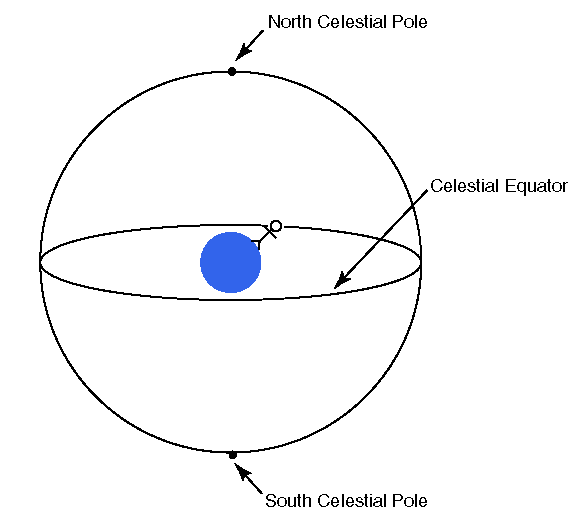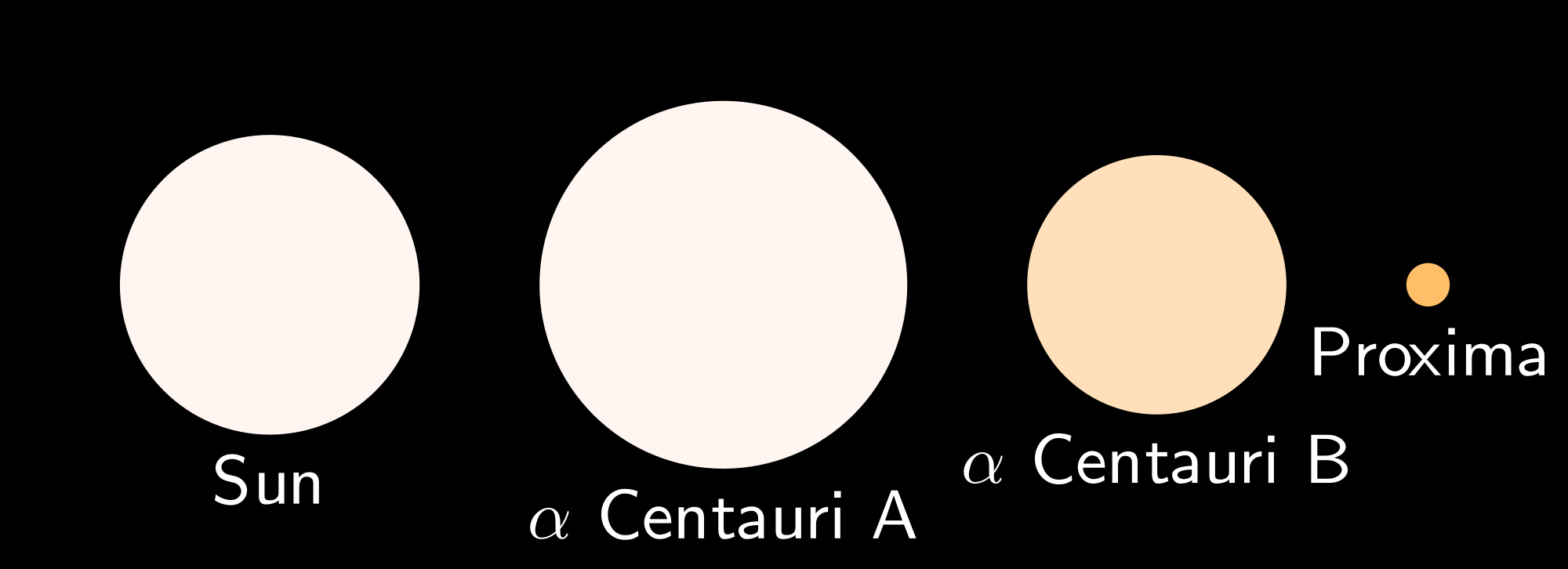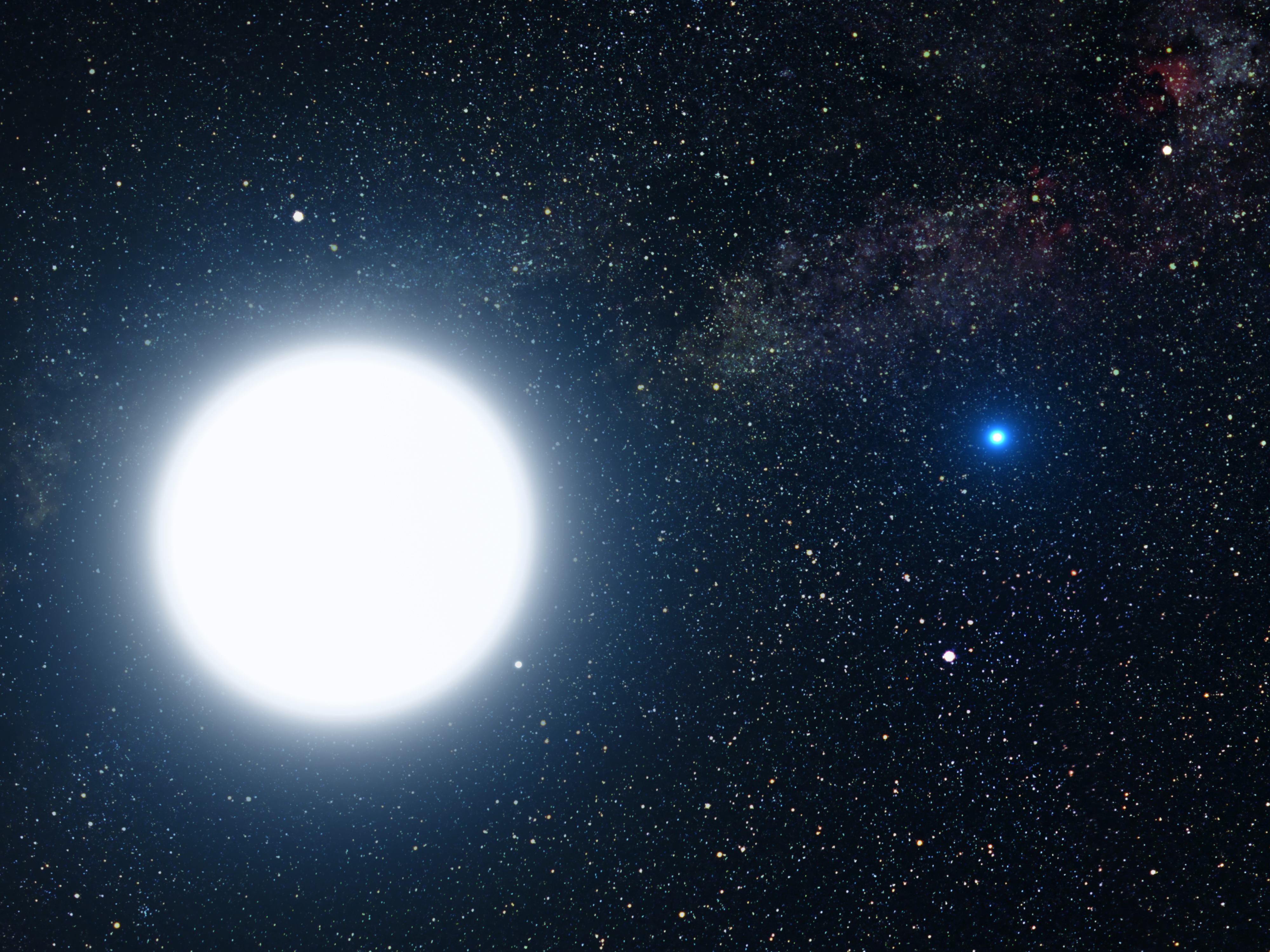Destinations in 3D
Stellar destinations require a 3 dimensional (3-D) model.
To map a planet's current location , one just needs to determine planet's current Right Ascension (RA or α), distance remains fairly constant since most planets orbit Sol in a near perfect circle (elliptical eccentricity ≈ 0). For simplicity, Thought Experiment (TE) arbitrarily assumes all planetary orbits to be circular as well as coplanar.
In fact, each planetary orbit occupies a plane uniquely inclined to the Celestial Equatorial Plane (CEP) which means most planetary positions are always slightly above/below CEP. Thus, interplanetary travelers will certainly consider these planetary vertical distances; however, they are quite small when compared to stellar dimensions and can be ignored in regards to an interstellar model.
 Celestial Equator projects Earth's Equator into space. Thought Experiment (TE) uses the term, Celestial Equatorial Plane (CEP), to indicate the plane defined by the celestial equator. For simplicity, TE arbitrarily assumes all planets to reside on CEP. (In fact, even the Earth's orbital plane, ecliptic, is inclined to the CEP. However, the offset from CEP is slight when compared to stellar dimensions). Celestial Equator projects Earth's Equator into space. Thought Experiment (TE) uses the term, Celestial Equatorial Plane (CEP), to indicate the plane defined by the celestial equator. For simplicity, TE arbitrarily assumes all planets to reside on CEP. (In fact, even the Earth's orbital plane, ecliptic, is inclined to the CEP. However, the offset from CEP is slight when compared to stellar dimensions). |
| Right Ascension. (RA or "α") is celestial "longitude". Much like terrestrial longitude, RA increases in value as one travels away from the zero value. RA increases in a counter clockwise (easternly) direction from Aries (♈). α is customarily measured in hours(h), minutes(m), and seconds(s), while a circular arc is measured in degrees(°), minutes(') and seconds("). (Recall: 24 hours equals a full circle (360°); thus, 1h of RA equals 15° of arc; 1m of RA equals 15' of arc; and 1s equals 15" of arc. Due to their orbital motion, each planet's RA is ever changing in a fairly rapid manner. |
 Aries (♈) is commonly used as the reference for RA (α = 0°). ♈ marks Earth's position in its orbit during the Vernal Equinox. This is the date (around March 21) when Earth bound observers note the Sun crossing the celestial equator from south to north. This is commonly considered as one of the two annual dates where duration of day equals that of the night (e.g., "equi-nox" = "equal night"). Aries (♈) is commonly used as the reference for RA (α = 0°). ♈ marks Earth's position in its orbit during the Vernal Equinox. This is the date (around March 21) when Earth bound observers note the Sun crossing the celestial equator from south to north. This is commonly considered as one of the two annual dates where duration of day equals that of the night (e.g., "equi-nox" = "equal night"). |
Quickly Approximate Location
1. Assume Near-Circular Orbits. For simplicity, TE assumes circular orbits at an constant distance from Sol. For example, we assume that Jupiter is always about 5 AU from Sol . (As a matter of fact, none of the planetary orbits are exactly circular; eccentricities vary from .007 to 0.2.) 2. Line of Position (LOP). Given a circular orbit, planet's RA can determine a planet's location because a RA measurement (0 to 360°) can be represented by a Line of Position (LOP) as shown. The subsequent intersection with its orbit quickly determines planet's position(with respect to CEP). | |
Extrasolar planets. While all stellar neighbors should be visited for firsthand observations, perhaps the initial destinations should be the ones where local observations indicate most favorable conditions. Examples:
- Earth like planets in best orbits around M-class stars.
- Existence of asteroids and comets.

Local Stellar Neighborhood
There are 61 known stars (and 7 brown dwarf stars) within 17 Light Years (LYs) from Sol,
our home star (aka "Sun").
our home star (aka "Sun").
These 68 objects are grouped into 50 stellar systems.
In spite of being relatively close, only nine can be observed with the naked eye.
The map shows the closest 32 systems.
As an example, consider one of them in more detail.
The map shows the closest 32 systems.
As an example, consider one of them in more detail.
| Due to its proximity and size, Sirius appears as the brightest night time star to Earthbound observers. Modern telescopes show it to be a binary star system: a white main sequence star (Sirius A), and a faint white dwarf companion(Sirius B). The distance between them varies from 8.1 to 31.5 AU. Known as the "Dog Star" to Westerners, Sirius provided a key navigation aid for the Polynesians as they paddled their outriggers around the vast Pacific Ocean. | |||||||||||||||||||||||||
Right Ascension (RA) to Sirius
is the angle (101.29°) from Aries to the LOP to Sirius.
This is shown on an overhead view of the Celestial Equatorial Plane (CEP). Note this view eliminates perspective; thus, the distances of 5 and 10 LYs can now be shown as circles and not ellipses.
While planetary RAs change daily, star movements take centuries to be discerned by the human eye. Thus, TE considers stellar RAs to be static.
| |||||||||||||||||||||||||
Declination to Sirius
is -16.72° as shown on this edge-on view of the CEP.
LOP is lowered from its RA position on CEP to position of Sirius beneath the CEP. | |||||||||||||||||||||||||
.Stellar Distance
can be measured through a variety of methods.
|
|
from Sol to Sirius
can be drawn in a vertical plane as shown.
This plane is perpendicular to the Celestial Equatorial Plane (CEP) and aligned with the Right Ascension (RA) angle (101.29°).
Simple trig identities can resolve this vector into two components:
|
| ||||||||||||||||||||||||
| Star | Right Ascension (α) | Declination (δ) | Dist. (d) | 3-D Cartesian Coord. | ||||||||||
|---|---|---|---|---|---|---|---|---|---|---|---|---|---|---|
| Name | Hrs | Min | Sec | Deg | Deg | Min | Sec | Deg | Light-Years | dCEP | X | Y | Z | |
| Sol | 0h | 0m | 0s | 0.0° | 0° | 0' | 0" | 0.0° | 0.0 LY | 0.00 | 0.00 | 0.00 | 0.00 | |
Sirius
| 6h | 45m | 8.9s | 101.29° | -16° | 42' | 58" | -16.72° | 8.583 LY | 8.22 | -1.61 | 8.06 | -2.47 | |
| System | Convert α to
Decimal Degrees
| Convert δ to
Decimal Degrees
| Observed | d*cos(δ) | dCEP*cos(α) | dCEP*sin(α) | d*sin(δ) | |||||||
| α = Hr*15 + Mn/4 + Sec/240 | δ = Deg + Mn/60 +Sec/3600 | d = X2 + Y2 + Z2 | ||||||||||||
Travel Time
To approximate travel time to nearby stars, Thought Experiment (TE) proposes an heuristic which might be achieved given some reasonable assumptions.- TE assumes slight advances in current technology allow for large spacecraft to use particle accelerators as propulsion systems. TE further assumes these onboard accelerators will expel exact quantity of plasma particles at near light speeds to accelerate the vessel for a "g-force" such that onboard passengers and crew will experience an Earth like gravity. This assumption leverages Einstein's "Thought Experiment" where people onboard an accelerating elevator (at 9.8 m/s2) would feel same force as if they were static on Earth's surface. (This is sometimes called the "Equivalence Principle".)
- TE assumes constant g-force acceleration can bring the vessel to very high velocities; thus, operational requirements compel the vessel to decelerate the vessel at the end of the voyage (reverse the direction of the g-force vector). If the flight plan calls for constant g-force throughout the flight, then the deceleration duration must equal the acceleration duration. In subsequent work, TE shows that one year of g-force acceleration can take the vessel to approximately .644 light speed (c) after the vessel travels a distance of 0.38 LY. Thus, the flight plan requires vessel to start deceleration at about .38 LY from destination for about one year's time. Thus, one year's acceleration plus one year's deceleration account for about .76 LY; however, the closest stellar neighbor is over 4 LY away.
- TE assumes g-force's plasma acceleration will convert considerable quantities of mass to energy. In fact, preliminary research indicates fuel requirements could easily exceed entire gross weight of vessel; thus, TE considers impractical (if not impossible) to g-force power the vessel for entire distance to destination star. Thus, TE arbitrarily assumes a duration of one year for acceleration plus another year for deceleration. Thus, TE's flight plan will require a long cruise period between acceleration phase and deceleration phase.
- TE assumes during cruise phase, Earth like gravity will be simulated via carefully controlled longitudinal spin of the vessel. Cruise duration (as observed from Earth) can be computed by a simple motion equation as shown below. Crew/pax will experience much shorter cruise duration due to relativity.
- TE assumes flight profile from Sol to Sirius to be modeled as follows:
| Acceleration: time = tAcc = 1 year; distance = dAcc= .38 LY |
| Deceleration: time = tDec = 1 year; distance = dDec= .38 LY |
| Cruise: ---Distance: dCru = dSiri - dAcc - dDec = 8.58 LY - .38 LY - .38 LY = 7.82 LY ---Time: tCru = dCru / vCru = 7.92 LY / (.644c) = 12.14 years |
| Total Travel Time to Sirius = tAcc + tCru + tDec = 1.0 yr + 12.14 yr + 1.0 yr = 14.14 yrs |
Thought Experiment (TE) lists eight closest stellar systems.
These are our Sun, Sol, plus the seven neighbors within 10 LYs.
| ||||||||||||||||||
(click for more)
| ||||||||||||||||||
(click for more)
| ||||||||||||||||||
(click for more)
| ||||||||||||||||||
| ||||||||||||||||||
| ||||||||||||||||||
(click for more)
| ||||||||||||||||||
(click for more)
| ||||||||||||||||||
(click for more)
| ||||||||||||||||||














0 Comments:
Post a Comment
<< Home